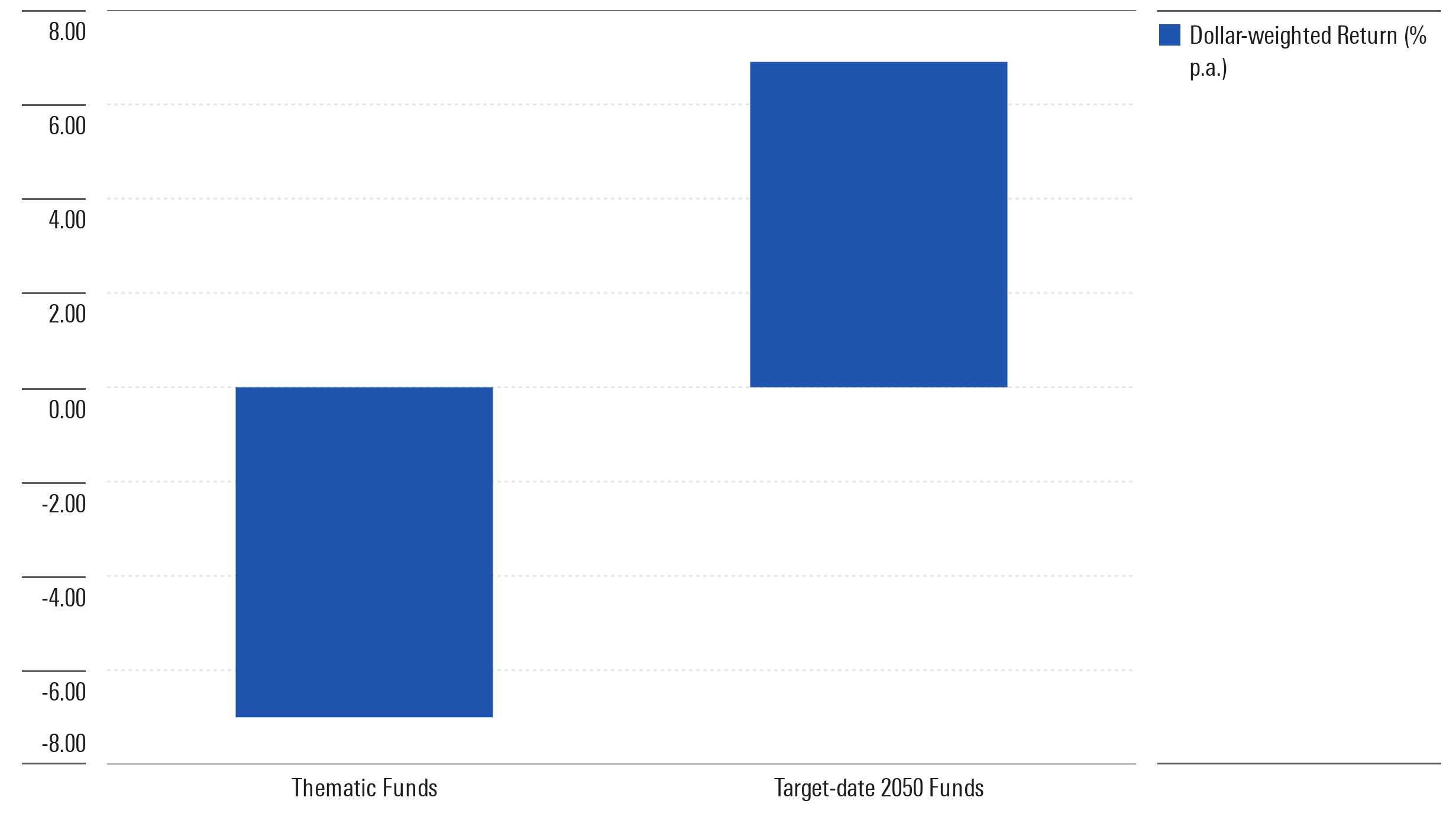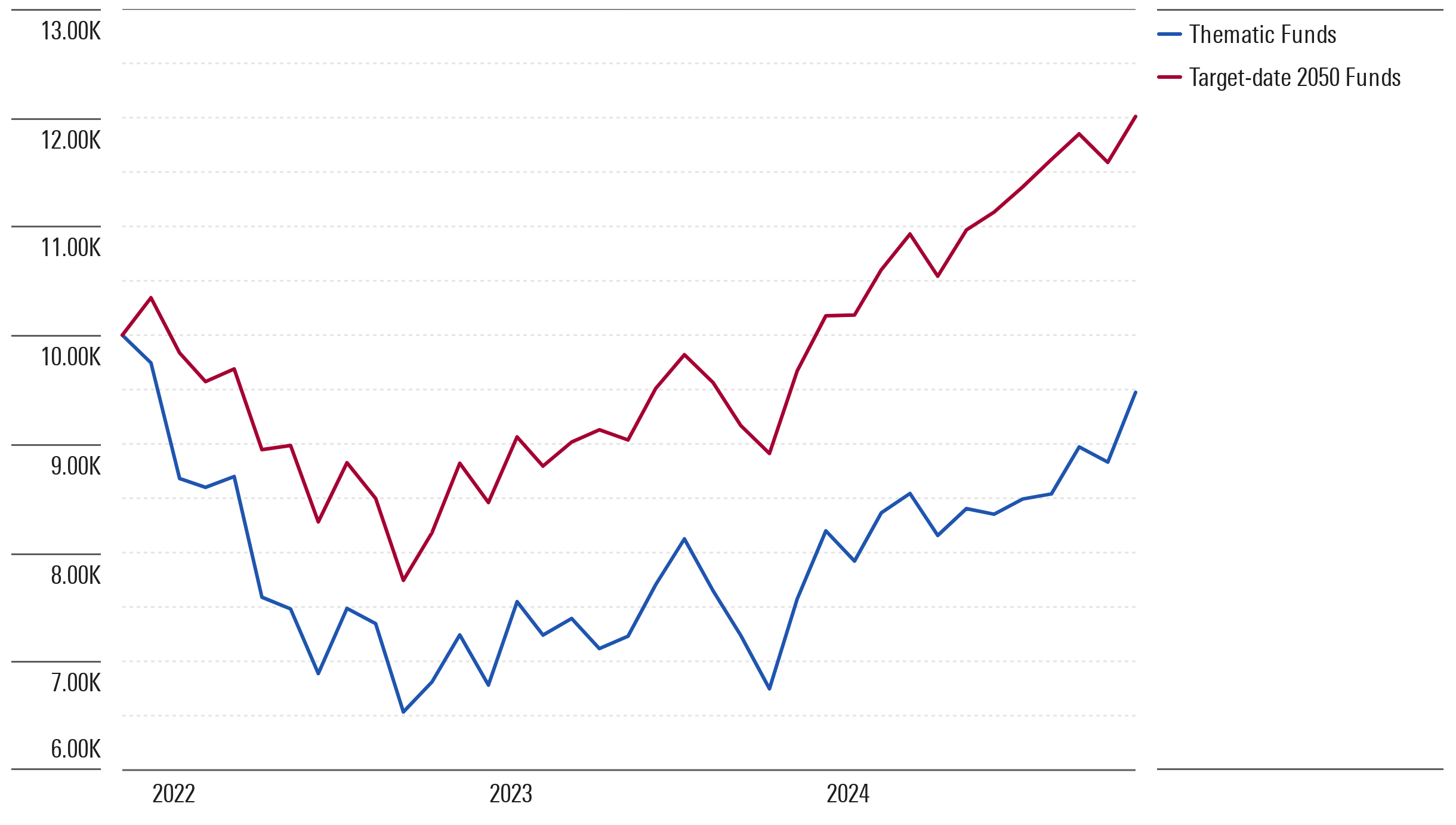What Does it Cost to Be Entertained By Your Investments? Try 14% a Year
January 16, 2025
You want entertainment, go to the movies. Don’t seek it out in your investments. At least that’s what data I’ve been analyzing suggests.
Let me explain: I was interested in how investors in “thematic” funds have fared. For those unfamiliar, thematic funds typically track indexes that filet the market into thin slices based on a theme like innovation, cloud computing, artificial intelligence, financial technology, cybersecurity, cancer, airlines, you name it. These strategies are more entertaining by their nature because they tend to tap into a trend that’s captured the imagination or entered the discourse somehow.
To gauge how investors in thematic strategies had done, I pulled together the funds’ aggregate net assets and flows over the three-year period ended Nov. 30, 2024. I chose this period because a lot of thematic funds launched within the last five years or so. But since we can only work with whatever funds existed at the start of the period—and not those that were launched three to five years ago—I chose to focus on the trailing three years, as that captures a good cross-section of the funds that came out.
Using that data, I estimated the funds’ aggregate dollar-weighted return (aka “internal rate of return”) over those 36 months. This estimate accounts for the timing and magnitude of investors’ purchases and sales of these funds during that stretch of time.
What I found is that, over those three years, the average dollar invested in thematic funds lost around 7% per year. Even when you remove the largest thematic fund―ARK Innovation ETF ARKK, which famously soared, gathered billions in assets, and then fell like a stone―these funds still lost almost 6% per year in dollar-weighted terms. To put that in perspective, the S&P 500 gained more than 11% per year over that span.
Dull vs. Entertaining
To be fair, thematic funds are aggressive strategies. They own stocks with bright growth prospects but that can be suddenly upended by changing investor sentiment. That’s made them more volatile than the broad market, and 2022 was especially punishing, with the average thematic fund skidding to a 30% loss. So, you could argue that, while a 7% annual loss is painful, it’s part of the trade-off you make for the chance at potentially big long-term returns.
Then again, it’s not like thematic funds are the only way to compound capital long-term. There are plenty of other strategies that have broadly similar risk/return attributes. Given that, I thought it could be illuminating to compare thematic funds’ dollar-weighted returns with those of a diversified stock-based strategy―but not just any strategy: I wanted something that was as boring as themes are exciting. The dullard I chose? Target-date 2050 funds.
Target-date 2050 funds are nobody’s idea of fun. They spread their assets widely across a portfolio composed primarily of global stocks and rebalance on a regular basis, adjusting the asset mix as time goes on. It’s about as purely utilitarian as you’re going to get. But they’re a good comparable given they had a roughly 30-year horizon as of November 2021 (to the 2050 target date) and held a similar sum of assets ($152 billion as of November 2021 versus $190 billion for thematic funds).
I ran the same calculation for target-date 2050 funds as I did for thematics, adding up the target-date funds’ assets and flows to estimate how the average dollar invested in those strategies did over the three-year period ended Nov. 30, 2024.
Where’d it come out? The average dollar invested in target-date 2050 funds gained nearly 7% per year.

In other words, dull beat entertaining by 14% annually. To put that in dollar terms, had you invested $10,000 in thematic funds as of Nov. 30, 2021, you’d have lost more than half your investment over the ensuing three years, finishing with around $4,800. Whereas if you’d put the same sum in target-date 2050 funds, you’d have nearly doubled your money by the end.
Lessons for Investors
Why did thematic funds fare so poorly when compared with prototypically dull investments like target-date 2050 funds? There are three factors I think explain it, and each holds its own lesson for investors:
1) Thematic funds were poor performers.
I find that the average thematic fund lost about 1% per year on a time-weighted basis. (To derive funds’ aggregate time-weighted return, I calculated the funds’ asset-weighted average net return each month and then compounded the monthly return series.) In other words, had investors made a lump-sum purchase on Nov. 30, 2021, and held to the end, they’d have lost money. Target-date 2050 funds, by contrast, earned a roughly 6.3% time-weighted annual return over that span. The difference―more than 7% per year―accounts for nearly half of the 14% per year shortfall in the return of the average dollar invested in thematics and target-dates.

The lesson? Be contrarian, not a bag-holder.
You generally aren’t going to see a thematic strategy launch after a stretch of poor performance by the underlying stocks. Indeed, the track record is kind of the point, as it draws investors into the theme and revs them up about the fund’s future. That’s why they’re not rolling out newspaper- or department-store-themed exchange-traded funds. No gains, no story, no dice.
The corollary to this is that, by the time a thematic fund reaches investors’ attention, it might already have been picked over by other investors who had already tapped into the theme. That can leave thematic fund investors holding the bag―that is, an overvalued basket of stocks that courts hefty price risk. And, indeed, the thematic funds I analyzed were trading at a steep 29 times projected earnings as of Nov. 30, 2021, which well exceeded the broader market’s valuation at that time.
It’s fine to be fired up about an emerging technology or a promising medical advance, but the time to buy isn’t when those themes are the toast of Wall Street. It’s after they’ve gotten crushed, as by then, the hot money has been chased off and valuations are less likely to be stretched.
The trick is finding a beaten-down thematic fund that the fund company won’t mothball (a risk because, by then, the fund’s assets will have shriveled, dimming its commercial prospects) and ensuring the index that the fund tracks will stick with the names that have gotten pounded, as opposed to rotating away to other stocks that weren’t hit as hard.
And if you’re not up for that, a nice target-date 2050 fund beckons.
2) Thematic fund investors mistimed their transactions.
As mentioned, thematic funds lost 1% per year on a time-weighted basis, but the average dollar lost around 7% per year. What explains the gap? Mistimed purchases and sales.
To illustrate, below I’ve plotted thematic funds’ aggregate monthly flows (x-axis) against the funds’ asset-weighted average return over the six months that immediately followed. In general, gaps will tend to form when investors withdraw assets before returns improve (top-left quadrant) or when they add monies before performance slips (lower-right). Unfortunately, thematic investors appear to have done a lot of buying high and selling low. (This is nothing new, as my colleague Amy Arnott found when she examined thematic funds’ dollar-weighted returns a few years ago in this article.)

Yes, investors in target-date 2050 funds also saw a gap—around 65 basis points per year—but it was way narrower.
The lesson: Reject discretion, embrace structure.
It’s kind of hackneyed to tell investors that they need to have a long-term mindset if they want to achieve a better result. The challenge for them is adopting such a mindset to begin with. And when you’re talking about products like thematic funds that are built to push our buttons, it’s even more difficult. In that sense, it’s not terribly surprising that investors have struggled to use thematics successfully.
But it’s not hopeless. If you’re hell-bent on investing in thematic strategies, you can mitigate the risk of costly timing errors by spreading your investments out over time a la dollar-cost averaging. No, this doesn’t extinguish the risk altogether, but it at least helps to keep impulses at bay.
Incidentally, this appears to have been the key for target-date 2050 investors, who invested like clockwork in those strategies through regular retirement plan contributions they made, capturing most of the funds’ returns in the process. If you can’t beat ‘em, join ‘em.
3) Thematic funds cost more.
Although it’s a distant third of the three factors, it’s worth noting that thematic funds are more expensive than target-date 2050 funds. On a dollar-weighted basis, investors paid about 0.77% per year in fees on thematic funds, which is more than thrice the cost that target-date 2050 investors incurred.
The lesson: Treat the extra cost like a “hurdle rate.”
Thematic funds charge more because they’re quasi-active. The indexer puts its muscle into developing a proprietary technique for capturing a theme that it expects will confer a higher return than a traditional diversified stock index.
Alluring as that might sound, you’re better off thinking of the extra expense as a hurdle that the fund must clear to succeed. In that way, you’re likelier to ask the hard questions—where will the fund’s excess return come from, for instance—and less prone to rationalize (“Everyone is going to want these products,” “This technology is going to change the world,” and so on).
Remember―if it’s obvious to you, then it’s probably also apparent to others. And if others reached the same conclusion as you, then it stands to reason those expectations have already been baked into the stocks’ prices.
Or you could skip all of that and just opt for a boring ol’ target-date 2050 fund that costs far less and demands no similar leaps of faith.
Switched On
Here are other things I’m reading, listening to, and watching:
- Acadian’s Owen Lamont: “Goodhart’s Law of Active Management”
- Jason Zweig on “toxic” market forecasts
- Tom Brakke’s “Fortnightly” roundup of all things investing
- Christine Benz on investing mistakes to avoid in 2025 (that is, don’t chase returns; don’t underdo international equity; don’t overdo equity risk entering retirement; don’t think you can forecast interest rates; don’t sleep on inflation)
- Amy Arnott on flexible retirement spending strategies
- The Money Stuff podcast with Katie Greifeld and Matt Levine: Exhuming Fannie/Freddie, B-school project gone awry, why you don’t want futures exchange warehouse cocoa
- The Bug Club: “We Don’t Care About That”
- Escape at Dannemora (which is available on Netflix now)
Feed Me!
I love hearing from you. Have some feedback? An angle for an article? Email me at jeffrey.ptak@morningstar.com. If you’re so inclined, you can also follow me on Twitter/X at @syouth1, and I do some odds-and-ends writing on a Substack called Basis Pointing.
The author or authors do not own shares in any securities mentioned in this article.
Find out about Morningstar’s editorial policies.
Search
RECENT PRESS RELEASES
Related Post




